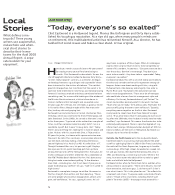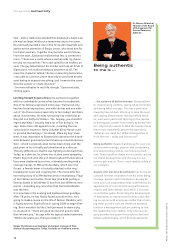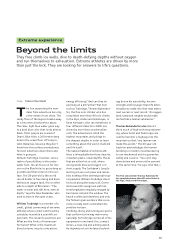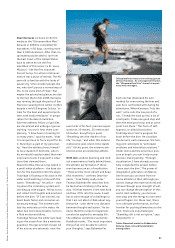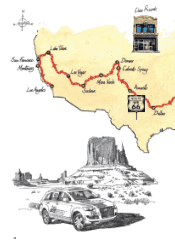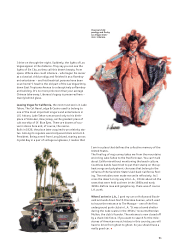Audi 2008 Annual Report Download - page 84
Download and view the complete annual report
Please find page 84 of the 2008 Audi annual report below. You can navigate through the pages in the report by either clicking on the pages listed below, or by using the keyword search tool below to find specific information within the annual report.
81
Dean Karnazes is known in the U.S.
media as the “Ultramarathon Man,”
because in 2006 he completed 50
marathons in 50 days, covering more
than 2,000 kilometers. After that, he
spontaneously decided to run from
the East Coast of the United States
back to where he ran the first
marathon of this series, to St. Louis,
Missouri – like the film character
Forrest Gump, for whom continuous
motion was a place of retreat. The 46-
year-old is familiar with the looks of
passers-by “who consider people like
me, who don’t pursue a normal way of
life, to be some kind of freak.” But
maybe the astonished glances are due
to the fact that in fall 2008, Karnazes
was running through the parks of San
Francisco wearing thick winter clothes
despite a mild 20 degrees Celsius “to
train for the heat and expected prob-
lems with body ventilation” in prepa-
ration for the desert marathon.
Extreme athletes follow a rigid diet,
are disciplined and undergo rigorous
training. You won’t hear them com-
plaining. “I have been in training for
so many years,” says Karnazes, “that
I no longer have to force myself to do
it. Running is a part of my personal-
ity.” Here the athlete shows himself
to be a student of Aristotle, who in
his moral philosophy stated that man
only learns traits if exposed to situa-
tions that demand them.
Above the Blue Hole at Long Island is
a small white platform – the base sta-
tion for the expedition into the abyss.
Trubridge is floating on his back in the
water and breathing in time with the
waves. “Breathe-up,” he calls it – slow-
ing down the circulatory system and
stocking up with oxygen. He has to try
and collect his thoughts and emotions
before the dive. “If I am worried, my
heart beats faster and consumes un-
necessary energy.” The extreme ath-
lete lies motionless in the water. He
takes two more deep breaths, turns in
a fluid motion and dives.
Trubridge follows the white rope lead-
ing to the ocean floor like a maritime
guardrail. His eyes are half-closed. All
of his actions are automatic now: the
even kicks of his feet, pressure equal-
ization at 10 meters, 25 meters and
50 meters. Everything is quiet.
“Breathing sets the rhythm of our
life,” he says, “and when this natural
metronome goes silent, time stands
still.” At this point, the extreme ath-
lete becomes an existential athlete.
With diet, endless planning and med-
ical examinations finally behind them,
the athletic performance of these
men becomes an act of meditation.
“These are the most vibrant and beau-
tiful moments,” confirms Dean Kar-
nazes, “I can finally really relax.”
Thomas Bubendorfer describes how
he feels when climbing in the same
way. “All that matters is the next hold
and how it fits into the route. A wall
has to pose enough of a challenge so
that I am not able to think about any-
thing else – until there is no distance
between thought and action.” He be-
lieves that this recipe for happiness
can also be applied to everyday life.
The athletes sometimes sound like
Buddhist monks. “The most important
thing of all is to be able to control
your thoughts,” says Bubendorfer.
Each one has developed his own
method for overcoming the fear and
pain he is confronted with during his
adventures. When Karnazes “hits the
wall,” as he calls the low point of a
run, “I break the task up into a lot of
small parts; I take one good step and
then the next good step, and at some
point I am there.” This form of self-
hypnosis is called dissociation.
Trubridge also tries to program his
brain before the dive. He visualizes
the descent, each maneuver, the turn-
ing point; attempts to “anticipate
problems and internalize solutions.”
Under stress and the enormous pres-
sure at depth, you can’t rely on your
decision-making ability. “Through
visualization, I have already success-
fully completed the project before
I even start the dive.” The power of
imagination generates confidence.
One lesson you can learn from ex-
treme athletes is that, although you
cannot change the material world and
its laws through pure strength of will,
you can change the perception of this
world. And suddenly, you discover
new ways and the energy to overcome
yourself again. For these men, there
is no ultimate performance, no final
frontier for pushing themselves to the
limit. There are only challenges.
“Standing still is not an option,” says
Bubendorfer.
Tobias Moorstedt works for Süddeutsche
Zeitung, Neon, GQ and Handelsblatt,
among others.
Inhospitable territory is the training ground
of Dean Karnazes. As a management trainer,
the “Ultramarathon Man” shares his experi-
ences with managers.
Photos: Peter Rohrmoser, Patrick Becker/FPA, Richard Robinson (2), The North Face (2)





